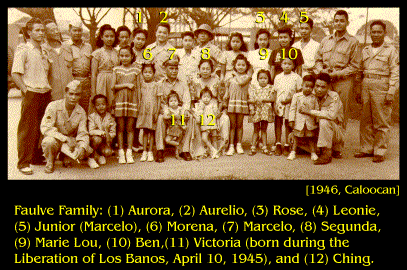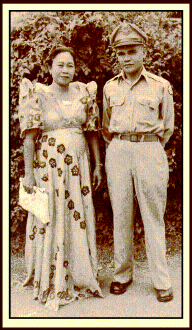
My high school teacher who was a guerrilla was an extremely reliable source of information. One day he told me "the Americans are in Leyte." Later, he told me to "be prepared the Americans are coming and the Japanese are sure to massacre." Very early one morning we were awakened by a droning sound coming from the bay. The sound became increasingly louder and soon crunching sounds coming from the street. Unable to keep concealed in our house any longer, we went outside and saw my father talking to an American in an amtrac. He told us that he had to go with the other soldiers and that we should go hide in the fox hole we had built. When the American planes began bombing in the area in anticipation of the operation which led to the liberation of the internees at UP Los Baņos, two of my brothers had been injured by shrapnel from one of the bombs dropped by these American planes. One brother had shrapnel stuck in his leg while the other one had who had all but his rear-end covered by the overturned bangka[fishing boat described above] was injured you-know-where.
After the Americans and allies liberated the internees from UP, they left and the Japanese came down from the mountains from where they were hiding. My father was left with two hand grenades. The massacre began with the dogs. I had a suitor at the time who had been visiting me. He was just leaving my house one night and began walking down the steps outside our front door when we heard the most sorrowful howl come from a dog. He came back in the house frightened and said, "What was that? That's a sign that someone is going to die. Better take care." The next morning we learned that all the dogs had been killed. They were bayoneted that's why the massacre was so silent. [The real massacre occurred later. Men, women, and children were tied to the foundation posts of homes nearest the internment camp and these house were set afire. A graphic accounting of what the returning American forces discovered can be found in The Los Baņos Raid by Lieutenant General Edward M. Flanagan, Jr., more information can be found at the end of this site. ]

We decided to make our way to safety aboard the bangka. There was about twenty of us in all on the bangka: family, relatives, and friends when we pushed off from the shore to go to Calamba where the Americans were by this time. Before we had gotten too far a chain that held one of the outrigger's poles to the hull broke and the bangkabegan to sink. One of my sisters jumped into the water in panic she didn't know how to swim and was saved by a friend who grabbed her by her long hair. Most of the passengers could not swim, my mother was pregnant, my baby sister was on board, and the boat was mortally wounded. We were able to get the boat stabilized so that it would not sink any further, but the water level was near to the top of the hull and all we could do was hang on and float in the Laguna de Bay. We were too far from the shore to hope to make it there. At dusk we could see that the sky above Bayan was lit up orange from fire and the water smelled of kerosene. To make things worse, the wind was blowing hard and the water was choppy. My uncle was saying prayers in Latin and my sister, Aurora, clung to a statue of Saint Anthony. By sunrise the next day, the wind had died down and our bangka was closer to shore so we started to kick with our legs to move it even closer. We saw a bag of money but had no hope of getting it and we saw pieces of our belongings float by. We were finally aided by an ex-leper who was my father's kumpare [a godfather of one of his children].

The Japanese had fled to the mountains in escape from the advancing Americans by this time but they had tried to destroy anything they left behind. When we reached shore and began walking along it we saw lots of dead people littering the shoreline. There were burnt carabao that looked like black boulders.
Later we learned more of what had happened before the Japanese retreated for good. There were three German-American sisters: Agnes, Helen, and Mary living in Los Baņos who happened to be relatives of our next door neighbors at Fort McKinnley. Their brother was in the navy. They had been able to avoid being placed in the concentration camp at the University only because they convinced the Japanese they were of German descent (remember the Germans were allied with the Japanese). When the Americans were already in Calamba, and the Japanese began rounding up everyone at Bayan, Agnes, who had blond hair, was caught trying to escape. Thirteen men raped her and then cut her to pieces. We also learned that Filipinos were lined up in rows by the Japanese soldiers at Bayan (these were a different group from the ones from the supply and command group who fraternized with the Filipinos in my barrio). Then they were bayoneted one by one. An eight-year old boy had survived by moving further down the line after one, then another was slaughtered and he eventually escaped to later tell how it had happened. One mother saved her child. She knew that there was to be one bayonet stab in her abdomen and then another into her lung after she fell so she held her baby away from where the bayonet struck her. Agnes's sister, Helen was the one who led the Americans into Los Baņos.
 Segunda and Marcelo
1946
Segunda and Marcelo
1946

Some of the participants in the final battles of Southern Luzon, including groups along with the Americans, involved in the liberation of Los Baņos, the internment camp there, and other towns nearby:
- Makapilis (Makabayang Katipunan ng Pilipino, or Philippine Nationalist League; sometimes derisively referred to as the "Brown Japs") were formed sometime in 1944 at the instruction of the Japanese occupation government though officially established in December 12th of that year. They fought alongside the Japanese in Rizal, Laguna and Bulacan provinces against the American forces and its allies.
- Hunter's Guerrillas (or Hunter's ROTC Guerrillas) were former cadets of the Philippine Military Academy other ROTC students and college undergraduates who waged a guerrilla campaign against the Japanese in the countryside by hunting (from which they received their appellation) and fighting them.
- PQOG (President Quezon's Own Guerillas).
- Hukbalahap (Hukbo Ng Bayan Laban sa Hapon, the Philippine People's Anti-Japanese Army).
- Hua Zhi (also Wha Chi, or Wah Chi were the Feilubin Huaquiao Kangri Zhidui, Philippine Chinese Anti-Japanese Guerrilla Force). At the beginning of the war, non-assimilated Chinese were the largest alien group in the Philippines making up about 71% of the 165,813 foreign citizens located there. Still they represented only .7% of the population. Formed from a Chinese leftist organization, the Hua Zhi was established on May 19, 1942 and consisted of fifty-two men with seven rifles and two side arms who were designated as Squadron 48 of the Hukbalahap. They, along with other guerrilla groups, increased their arsenal by collecting weapons left behind by the Fil-American forces in Bataan and Zambales. By some accounts their number grew to seven hundred by the end of the war, though their contingents fighting in the Los Baņos area were much smaller.
SOME BOOKS DEALING WITH THESE EVENTS:
- The Huaqiao Warriors, Yung Li Yuk-wa, © 1995, Hong Kong University Press. Examines the Chinese-Philippine Guerrilla Movement during World War II.
- The Japanese Military Administration in the Philippines and the Tragedy of General Artemio Ricarte, Setsuho Ikehata; translated by Elpidro R. Santa Romana © 1991, National University of Singapore. A pamphet that examines the Philippine collaboration with the Japanese focusing on the involvement and efforts of a Filipino nationalist who had emigrated from the Philippines to Japan after the Spanish American War and returned to his home only after the Japanese Occupation began.
- The Los Baņos Raid, Lt. General Edward M. Flanagan, Jr. USA (Ret.), © 1986, Presidio Press. Examines the raid on the internee camp from the American perspective and some of the consequences of the event on un-liberated locales in the following days. Also has a list of all the names and nationalities of those interned at the Los Baņos concentration camp.
- The Wainwright Papers, Volume 1, Edited by Celedonio A. Ancheta, © 1980, New Day Publishers. An American military description of the Invasion of the Philippines good for its general chronological information.

